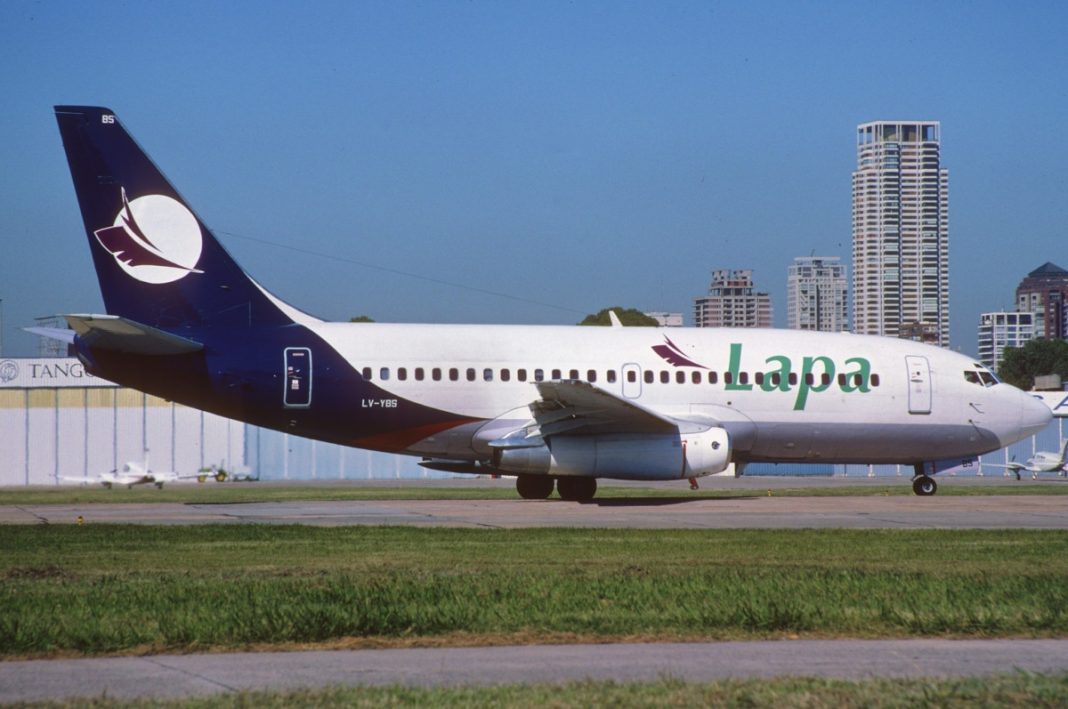Líneas Aéreas Privadas Argentinas, better known as LAPA, was an Argentinian carrier. It was the first private company to run domestic flights in the country, battling against the State operators Aerolíneas Argentinas and Austral. But what happened to LAPA? Why did it disappear? Let’s investigate further.

The origins of LAPA
It was 1977 when LAPA first took flight. Count Claudio Zichy Thyssen created the airline in Argentina, following a long tradition of German businessmen launching carriers in South America during the 20th century.
By that time, Aerolíneas Argentinas had already been flying for over 27 years. Aerolíneas Argentinas and Austral were the State carriers in the country and had a monopoly in the sky.
LAPA’s original intention was to fly domestic routes from Buenos Aires.
During the first 16 years, LAPA struggled to compete under the Argentinian government rules. By 1988, it had a domestic map of ten routes and one international flight to Punta del Este in Uruguay. It had a fleet composed of Fairchild Swearingen Metro II and SAAB 340 planes.
In the meantime, Aerolíneas Argentinas was booming. During the 70s and 80s, Aerolíneas saw its golden age, launching flights through the South Pole and having a Boeing 747 fleet. It was in the 90s when LAPA had its highlights.

The 90s, the best days of LAPA
In 1993, the Argentinian government deregulated the airline market in the country. This decision helped LAPA grow during the decade, allowing it to compete with Aerolíneas Argentinas but with more accessible price tickets.
LAPA acquired 23 Boeing 737-200, three Boeing 757-200, and one Boeing 767-300ER, allowing the carrier to fly to the US. However, the longest route it ever operated was to Atlanta, starting in 1999.
During the 90s, LAPA established scheduled flights to five countries in America: Brazil, Chile, Bolivia, Uruguay, and the US. It also flew to 25 domestic cities in Argentina and charter flights to nine countries across Latin America and the Caribbean.
LAPA’s international scheduled flights were to:
- Uruguay: Montevideo and Punta del Este
- Brazil: Rio de Janeiro, Sao Paulo Florianopolis, and Porto Alegre
- Chile: Santiago de Chile
- Bolivia: Santa Cruz de la Sierra
- The US: Atlanta
LAPA’s international charter flights were to:
- Mexico: Cancun
- Dominican Republic: Punta Cana, and Puerto Plata
- Costa Rica: San José
- Aruba
- Puerto Rico: San José
- Venezuela: Isla Margarita
- St. Maarten
- Cuba: Varadero
- Brazil: Maceio, San Salvador, Rio de Janeiro, Sao Paulo, Porto Seguro Porto Alegre, and Florianopolis.
Finally, it flew domestically to Cordoba, Mendoza, San Juan, San Luis, Villa Mercedes, Tucumán, Salta, Jujuy, La Rioja and Catamarca, Posadas, Iguazú, Resistencia, Corrientes, Formosa, Trelew, Comodoro Rivadavia, Rio Gallegos, Rio Grande, Ushuaia, Mar del Plata, Villa Gesell, Bahía Blanca, Neuquén, Bariloche, and General Roca.

Why it disappeared?
LAPA’s final nails in the coffin were in the form of two different incidents. Firstly, there was the LAPA Flight 3142 accident. The airline operated the flight with a Boeing 737-204C flying from Buenos Aires to Cordoba. It crashed on 31 August 1999 while attempting to take off from Aeroparque Jorge Newbery. Sixty-five people died in the crash, including two that were on the ground. According to the statistics, a further 34 people were injured.
During the crash’s investigation, researchers discovered that the captain of the flight had his license expired.
The second event that led to LAPA’s disappearance was the Argentinian economic crisis in 2001. The crisis, which led to the resignation of then-president Fernando de la Rúa, gave way to a period of political instability with five different presidents. Therefore, the economy was terribly hurt, and LAPA’s wasn’t able to fly through the uncertainty. It went bankrupt in 2003.
Did you ever travel with LAPA? How was it? Let us know in the comments.
[ad_2]
Source link


